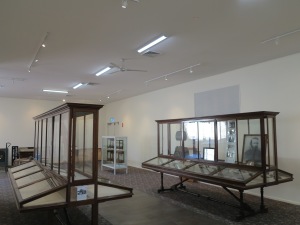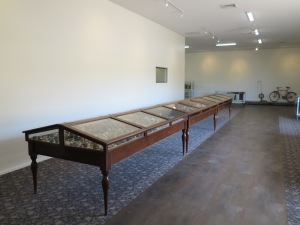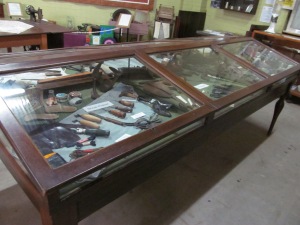Blog Archives
Still Engaging
The Museum Development Officers (MDOs) are currently engaging with their communities while working at home. This unfortunately means no workshops, display installation, oral histories, conservation, community meetings or any work that does not allow for adequate and safe social distancing. The MDOs will continue to assist by phone, email and depending on resources, video calls.
Although Melanie (Mackay) and Jo (Cairns) are used to working alone, Lydia (Toowoomba), Josh (Ipswich) and Ewen (Townsville) are all based in the Queensland Museum campuses which have now closed their doors to the public and encouraged staff to work from home.
Self and community isolation may be new to many people but the MDOs have all worked with remote communities who are used to isolation either by distance or by natural disasters such as flood. The MDOs have documented School of the Air radios, cleaned Flying Doctor objects, researched stories about Afghan traders servicing isolated pastoral stations, documented rural and remote health practices, researched quarantine stations on islands, and recorded the events of returning First World War soldiers and the Spanish Flu.
These objects and stories show resilience, innovation, adaptation and community spirit. They are in these museums because they are valued by the community and underscore their shared values and their desire to document what to them is often everyday life.
The MDO blog has recently added a new page with links to “how to videos”. Although these are designed as a basic introduction to a topic they may be useful if you need to undertake some work while your museum is closed or you have time at home. Please contact your local MDO if you need further information.

Image: John Flynn Place, Cloncurry.

Source: John Flynn Place, Cloncurry.
beautiful cases
Timber display cabinets that once housed Queensland Museum’s collections in Brisbane have been unearthing themselves in museums throughout the State. Mary Kathleen Park in Cloncurry and James Cook Museum in Cooktown have both been visited recently by Cairns based MDO, Jo Wills, and Townsville based Ewen McPhee where they came accross the cases. Further enquiries also found them in Kingaroy at the Kingaroy Heritage Museum. All of the cases appear to be in good condition, and most are intact with early glass and are being used as intended – to display the State’s moveable cultural heritage. They are also a collection object in themselves.
The cases came from the Old Queensland Museum in Brisbane when it was located in the Brisbane Exhibition Hall from 1899. Queensland Museum remained in this building until 1986 when a new Queensland Cultural Centre was constructed. In fact the cases may be even older than the Exhibition Hall phase as there were earlier buildings that were also used by Queensland Museum. For a history on other buildings used by the Queensland Museum have a look at this blog here.
Please leave a comment or get in touch if you know any more about the history of these display cases or if your local museum or collecting place has some as well.
Cloncurry Afghan Cameleers
The north-east corner of the old Cloncurry Cemetery is the resting place for many cameleers who lived and worked in Queensland during the late 19th and early 20th Century. Although there are many graves, only the headstones of Cloncurry Ghantown’s mulla (priest) Syid O Mar (1915), and aboriginal woman, Nellie Edwards (1936) remain. Nellie Edwards may have been a cameleers wife or a rare convert to Islam. Afghan graves are aligned north-south with the head in the north and the face of the interred turned towards Mecca, the Muslim holy city.
The Afghans and their camels were brought to Australia to provide transport for explorers and settlers in the arid inland where conditions were too harsh for horses and bullocks. Their camps were established on the outskirts of railhead towns and shipping ports and were known as Ghantowns. The cameleers, with their strings of camels, carried supplies, tools and machinery from the nearest railhead to homesteads, mining camps and townships. They returned with bales of wool and bags of ore. During the late 1890s and early 1900s there were more than 200 Afghans and about 2000 camels in the Cloncurry district making it the largest Ghantown in Queensland.
Museum Development Officers Ewen McPhee and Dr Jo Wills were in Cloncurry recently working with Gail Wipaki (Mary Kathleen Park) on a new exhibition space which will feature the Afghan cameleers.





